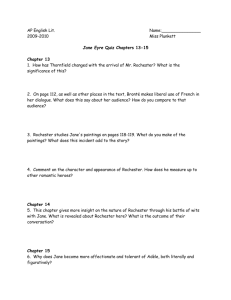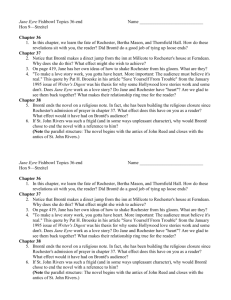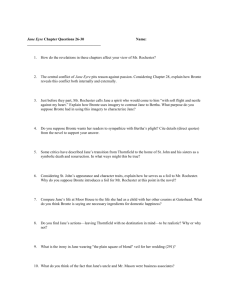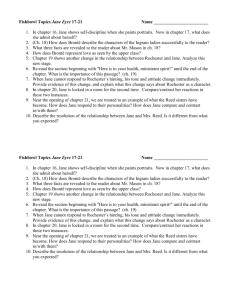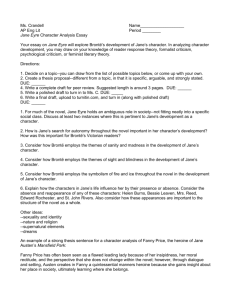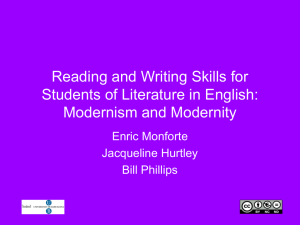Chapter 18 - English With Miss Robinson
advertisement
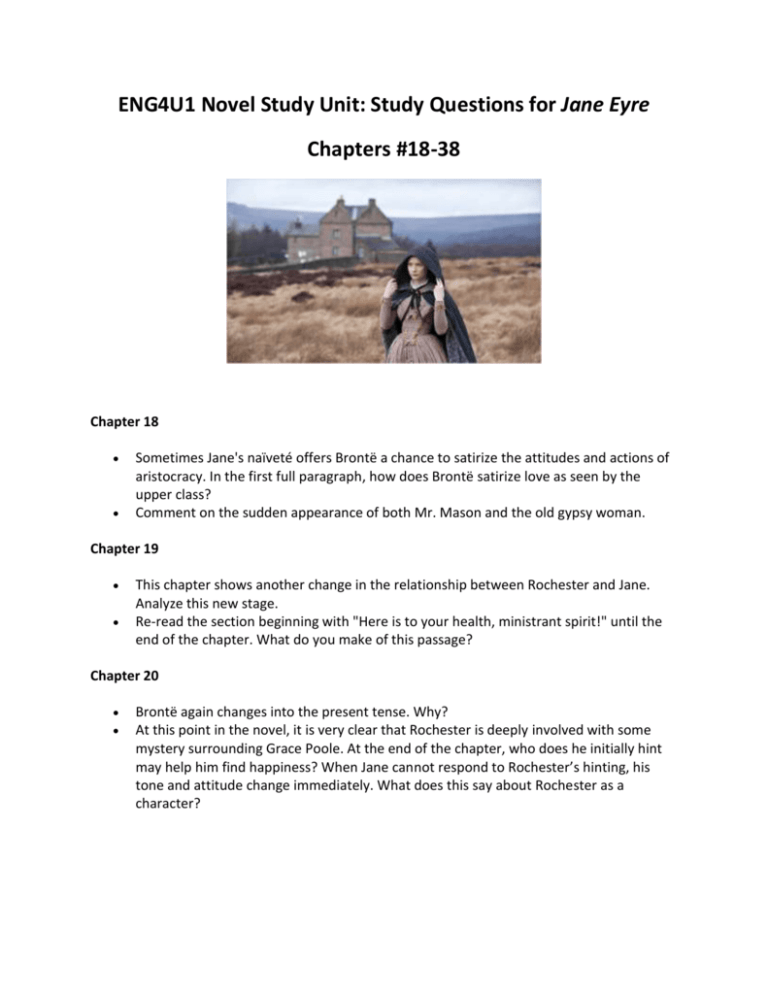
ENG4U1 Novel Study Unit: Study Questions for Jane Eyre Chapters #18-38 Chapter 18 Sometimes Jane's naïveté offers Brontë a chance to satirize the attitudes and actions of aristocracy. In the first full paragraph, how does Brontë satirize love as seen by the upper class? Comment on the sudden appearance of both Mr. Mason and the old gypsy woman. Chapter 19 This chapter shows another change in the relationship between Rochester and Jane. Analyze this new stage. Re-read the section beginning with "Here is to your health, ministrant spirit!" until the end of the chapter. What do you make of this passage? Chapter 20 Brontë again changes into the present tense. Why? At this point in the novel, it is very clear that Rochester is deeply involved with some mystery surrounding Grace Poole. At the end of the chapter, who does he initially hint may help him find happiness? When Jane cannot respond to Rochester’s hinting, his tone and attitude change immediately. What does this say about Rochester as a character? Chapter 21 Readers are treated to an example of what the Reed sisters have become. How does Jane respond to their personalities. How does Jane compare and contrast to them? Describe the resolution of the relationship between Jane and Mrs. Reed. Is it different from what you expected? Would it have been different from what Brontë's audience would have expected? Chapter 22 Chapter 22 is short and ostensibly deals with Jane's return to Thornwood. What function might this chapter serve in terms of the entire text? Note again the switch in tense. Chapter 23 Pay attention to Brontë's description of Thornfield in summer at the beginning of the chapter. Notice how it contrasts the events of the rest of the chapter. Notice also the change of weather and the destruction of the chestnut tree. As a reader, what effect should these incidents of "pathetic fallacy" have on you? In Jane's impassioned speech beginning with "I tell you I must go”, you should be able to find pieces of both Bessie and Helen Burns. How do the philosophies of these two influential characters color Jane's words? Chapter 24 This chapter is pure Jane Eyre. How is Jane different than most brides of romance stories? What would Brontë's audience have thought of her behavior? Chapter 25 When Jane regards her wedding gown, what mood does Brontë establish? Why does Brontë narrate with such a heavy hand when she writes "Stay till he comes, reader; and when I disclose my secret to him, you shall share the confidence"? Chapter 26 What is the irony in Jane wearing "the plain square of blond" veil for her wedding? What do you think of the fact that Jane's uncle and Mr. Mason were business associates? Re-read Jane's recollections of the events leading up to the introduction of Bertha Mason. How are these events different from similar events in traditional romantic novels? Why does Brontë "play" the scene this way? Chapter 27 "Reader, I forgave him at the moment on the spot". What is your reaction to this? When Rochester explains the circumstances of marriage to Bertha Mason, how do you respond as a reader? Does Brontë succeed or fail to produce sympathy for this character? How? Compare the symbolism of "(a) wind fresh from Europe" and the "fiery West Indian night". What do these symbols represent? Are they ironic in any sense? Jane explains her rationale for not complying with Rochester. Is this in character with the Jane we have come to know? How? Chapter 28 The suffering that Jane endures is compounded by her belief that she has "no claim to ask" for help. How is this philosophy in keeping with her character? As the author of the text, Brontë is the artist who chooses what events happen in the plot (much the same way a painter can choose the composition of a painting, or a sculptor can choose where and how to carve the elements of a sculpture). Why did she choose to create a section where her main character goes through so much pain? Is it appropriate? Chapter 29 Do a little research. Where do the names Mary, Diana, St. John, and Hannah come from, and what is the significance attached to those names? Compare the meanings of the names to their respective characters in the previous chapter and this one? Chapter 30 Compare the Rivers family to the Reed family. In what way are they similar? In what way are they foils? Do the names signify anything? Chapter 31 Jane's feelings toward her backwoods students and the "germs of native excellence, refinement, intelligence (and) kind-feeling" that "are as likely to exist in their hearts as in those of the best-born" are likely to have caused a stir among non-romantics of the period. Why? Why does Jane begin this chapter in the present tense? Jane Eyre is running from an unattainable love. Who else is running as well, and what are the details? Chapter 32 A good minister is an example to his congregation; followers will learn "truth" by simply observing the daily actions of their pastor. Does St. James Rivers impart any "truths" to Jane? Chapter 33 In this chapter, the final pieces of the puzzle slip into place. Is this resolution too coincidental or is it satisfactory? Chapter 34 Characterize the similarities and differences between St. John's offer of marriage and Rochester's. Why does Jane refuse St. John when she is willing to accept a life with him in India? Couldn1t she grow to love him? How does her response fit in with what we know about Jane as a character? Hot climates seem to have a special symbolic meaning in the text (note Rochester's discussion of the West Indies). What do you make of it? Chapter 35 Jane's conversation with Diana, although acceptable and unexceptional to us, would have bordered on the scandalous in Brontë's day. What is it about Jane's viewpoint that would have drawn so much anger? Does Jane's near surrender to St. John Rivers, stopped only by "the voice of Edward Fairfax Rochester" speaks to her "in pain and woe" diminish her strength of character? Why would Brontë have slipped again into the realm of the supernatural if Jane had enough strength in her own convictions? Chapter 36 In this chapter we learn the fate of Rochester, Bertha Mason, and Thornfield Hall. How do these revelations sit with you, the reader? Did Brontë do a good job of tying up loose ends? Chapter 37 Notice that Brontë makes a direct jump from the inn at Millcote to Rochester's house at Ferndean. Why does she do this? What effect might she wish to achieve? Jane has her own ideas of how to shake Rochester from his gloom. What are they? "To make a love story work you gotta have heart. More important: The audience must believe it's real." This quotation by Pat H. Broeske in his article "Save Yourself From Trouble" from the January 1995 issue of Writer's Digest was his thesis for why some Hollywood love stories work and some don't. Does Jane Eyre work as a love story? Do Jane and Rochester have "heart"? Are we glad to see them back together? What makes their relationship ring true for the reader? Chapter 38 Brontë ends the novel on a religious note. In fact, she has been building the religious closure since Rochester's admission of prayer. What effect does this have on you as a reader? What effect would it have had on Brontë's audience? If St. John Rivers was such a frigid (and in some ways unpleasant character), why would Brontë chose to end the novel with a reference to him? Note the parallel structure: The novel begins with the antics of John Reed and closes with the antics of St. John Rivers.

